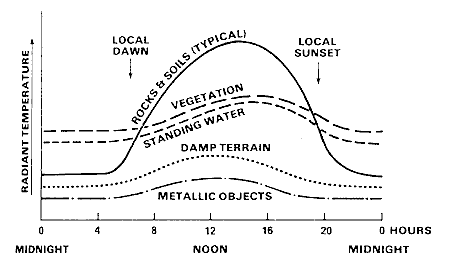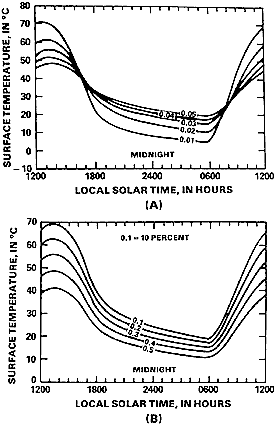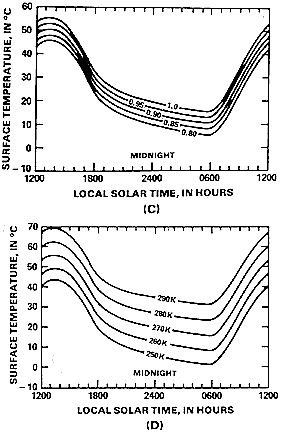
Unlike remote sensing of reflected light from surfaces in which only the topmost layers a few molecular layers thick are involved, thermal remote sensing is affected by energy variations extending to varying shallow depths below the ground surface. The most critical consideration in analyzing and interpreting thermal data and imagery is that of knowing the physical and temporal conditions under which the near surface layers are heated. Over the seasons, minor shifts in mean temperature in bedrock can occur to depths of 10 meters (33 ft) or more. Materials at and immediately below the surface are heated significantly during the day by incoming solar radiation and heat transfer from the air. Temperatures usually drop at night primarily by radiative cooling (with maximum radiative cooling under cloudless conditions), accompanied by some conduction and, for fluids, convection. During a single daily (diurnal) cycle, the near surface layers (commonly, unconsolidated soils) experience alternate heating and cooling to depths typically between 50 and 100 centimeters (20-40 inches). The daily mean surface temperature is commonly near the mean air temperature. Observed temperature changes are induced mainly by changes during the diurnal heating cycle but seasonal differences (averages and range) in temperature and local meteorological conditions also affect the cycle response from day to day.

Changes in radiant temperatures of five surface-cover types during a 24-hour thermal cycle. From F.F. Sabins, Jr., Remote Sensing: Principles and Interpretation. 2nd Ed., © 1987. Reproduced by permission of W.H. Freeman & Co., New York City.
The curves shown here summarize the qualitative changes in radiant temperature during a 24-hr cycle, beginning and ending at local midnight, for five general classes of materials found at the surface. From these curves one may estimate the relative gray levels that would be recorded in a thermal image, as a function of the material and the time of day. Given two thermal images of the same local, taken 12 hours apart, about noon and about midnight, one might determine the identities of co-registered pixels based on their temperatures and their thermal inertia.
Differences in thermal inertia, reflectances, and emissivity of various materials and variable atmospheric radiance are important factors that modify the measured surface temperatures. Consider the four sets of curves plotted below:


The top curves (A) show temperature variations resulting
solely from differences in thermal inertias of materials, with
other factors held constant. Note the distinct crossover points.
Values of P much higher than 0.05 (commonly, metallic objects)
produce diurnal curves that approach a straight line passing through
the crossover points; this is consistent with the earlier statement that
materials with high thermal inertias undergo smaller radiant temperature
changes during a full heating/cooling cycle. Curves in B show
the effects of different reflectances (in terms of albedo - the
ratio of reflected solar radiation to incident radiation, in percent);
both maximum and minimum daily temperatures and their differences
(delta T) increase with decreasing reflectance of solar insolation.
In C, the curves represent changes associated with different emissivities;
most natural materials have values of ranging from 0.80 to 0.98. Curves in D indicate the temperature
effects introduced by the sky (atmospheric) radiances caused by
re-emission from water vapor, a common source of error. It should
be obvious from these sets of curves that natural surface materials
will show considerable modifications in radiant temperatures because
of these variables.
The interplay among these varying properties combines to affect the rate of heating, total heat exchanged, and temperature profile (gradient = dT/dz, where z is thickness or depth) within the layers in the top 30 cm (1.2 ft) or so beneath the Earth's surface. This profile can change considerably during the diurnal cycle; different temperature vs depth profiles characterize different times of the day and night, as summarized in this diagram (for a low density soil with very low thermal inertia):
Regardless of time of day, temperature profiles in the heating zone converge on a nearly steady value at some depth below 30 - 50 cm (depending on whether rock or soil, and moisture content) but one that slowly increases into the Earth as the geothermal gradient takes over. Before dawn (06:00), the surface zone (top 50 cm or so) shows a diminishing rate of increase in ground temperatures (dT/dz is positive overall). In the morning sunlight (08:00), the uppermost 10 to 20 cm (4-8 inches) of a typical soil will begin to heat up rapidly, forming a negative dT/dz at shallow depth that reverts to a positive gradient in the lower near surface profile. By shortly after noon (12:00), the surface layers have reached maximum temperature while the lower layers have experienced successively less warming with increasing depth. Following sunset into the night (20:00), as heat is lost the gradient reverses (becomes negative) so that temperatures are lowered at the surface but remain warmer down to the base of the diurnal change zone.
The maximum and minimum temperatures at the observed surface (topmost
cm or so) depend largely on the extent of buildup of the heat
reservoir and its storage capacity through the affected layers.
For materials that have the same density and albedo but different
conductivities and/or specific heats, the difference in predawn
(lowest T values) and midday (highest values) increases with increasing
conductivity and decreasing specific heat. The actual magnitude
of the difference decreases with depth down to the stable (convergent)
value at base. The effect of increasing the material density (holding
other variables in constant) is to require more of a given amount of thermal energy
to be used in heating the additional mass in a given volume so
that less heat is transferred to lower layers. With increasing
density, the total added heat (derived from sun and air) is distributed
over a decreased thickness of surficial layers; in this instance,
the maximum T reached at midday is less and the minimum at night
is greater so that the spread of daily temperature extremes (delta
T) tends to be reduced relative to less dense materials. The corresponding
rise in thermal inertia for denser materials simply expresses
their increased resistance (sometimes referred to as thermal
impedance) to temperature changes (smaller delta Ts) as heating
or cooling progress. For materials with higher thermal conductivities,
more heat will be transferred to greater depths, less remains
concentrated at the surface, and, again, temperature extremes
diminish, as evidenced by lower daytime surface temperatures and
higher nighttime temperatures compared with materials having lower
Ks (e.g., soils).
Code 935, Goddard Space Flight Center, NASA
Written by: Nicholas M. Short, Sr. email: nmshort@epix.net
and
Jon Robinson email: Jon.W.Robinson.1@gsfc.nasa.gov
Webmaster: Bill Dickinson Jr. email: rstwebmaster@gsti.com
Web Production: Christiane Robinson, Terri Ho and Nannette Fekete
Updated: 1999.03.15.